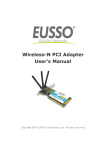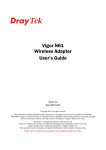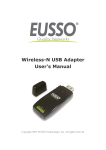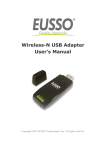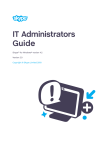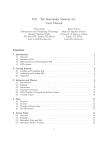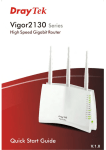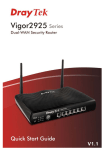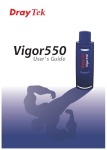Download Dolby Laboratories DP564 Network Card User Manual
Transcript
Vigor N61 Wireless Adapter User’s Guide Version: 1.01 Date: 2008/02/19 Copyright 2008 All rights reserved. This publication contains information that is protected by copyright. No part may be reproduced, transmitted, transcribed, stored in a retrieval system, or translated into any language without written permission from the copyright holders. The scope of delivery and other details are subject to change without prior notice. Microsoft is a registered trademark of Microsoft Corp. Windows, Windows 95, 98, Me, NT, 2000, XP and Explorer are trademarks of Microsoft Corp. Apple and Mac OS are registered trademarks of Apple Computer Inc. Other products may be trademarks or registered trademarks of their respective manufacturers. Please visit www.draytek.com to get the newly updated manual at any time. European Community Declarations Manufacturer: Address: Product: DrayTek Corp. No. 26, Fu Shing Road, HuKou County, HsinChu Industrial Park, Hsin-Chu, Taiwan 303 Vigor N61Wireless Adapter DrayTek Corp. declares that Vigor N61Wireless Adapter are in compliance with the following essential requirements and other relevant provisions of R&TTE Directive 1999/5/EEC. The product conforms to the requirements of Low Voltage (LVD) Directive 2006/95/EC by complying with the requirements set forth in EN60950. Regulatory Information Federal Communication Commission Interference Statement This equipment has been tested and found to comply with the limits for a Class B digital device, pursuant to Part 15 of the FCC Rules. These limits are designed to provide reasonable protection against harmful interference in a residential installation. This equipment generates, uses and can radiate radio frequency energy and, if not installed and used in accordance with the instructions, may cause harmful interference to radio communications. However, there is no guarantee that interference will not occur in a particular installation. If this equipment does cause harmful interference to radio or television reception, which can be determined by turning the equipment off and on, the use is encouraged to try to correct the interference by one of the following measures: z Reorient or relocate the receiving antenna. z Increase the separation between the equipment and receiver. z Connect the equipment into an outlet on a circuit different form that to which the receiver is connected. z Consult the dealer or an experienced radio/TV technician for help. This device complies with Part 15 of the FCC Rules. Operation is subject to the following two conditions: (1) This device may not cause harmful interference, and (2) This device may accept any interference received, including interference that may cause undesired operation. Please visit http://www.draytek.com/about_us/R_TTE_Certification.php for certificate document. This product is designed for the 2.4GHz WLAN network throughout the EC region and Switzerland with restrictions in France. ii Vigor N61 User’s Guide Table of Contents 1 Preface ...............................................................................................................5 Wireless LAN Basics..................................................................................................................... 5 Warning...................................................................................................................................... 5 2 Installation Overview.........................................................................................7 Introduction ................................................................................................................................... 7 Installation Procedure ................................................................................................................... 7 Uninstalling USB Driver............................................................................................................... 12 3 Configuration ...................................................................................................15 Wireless USB Adapter Utility....................................................................................................... 15 Configuration............................................................................................................................... 16 Status .......................................................................................................................................... 24 Option.......................................................................................................................................... 25 About ........................................................................................................................................... 27 4 Miscellaneous ..................................................................................................29 Windows Zero Configuration....................................................................................................... 29 Vigor N61 User’s Guide iii This page is left blank. iv Vigor N61 User’s Guide 1 Preface Thank you for purchasing Wireless LAN Adapter. This manual will assist you with the installation procedure and is valid for Wireless LAN adapters. Wireless LAN Basics Wireless LAN (Local Area Networks) systems offer a great number of advantages over a traditional, wired system. Wireless LANs (WLANs) are more flexible, easier to setup and manage and often more cost effective than their wired equivalence. Using radio frequency (RF) technology, WLANs transmit and receive data over the air, minimizing the need for wired connections. Thus, WLANs combine data connectivity with user mobility, and, through simplified configuration, enable movable LANs. With wireless LANs, users can access shared information without looking for a place to plug in and network managers can set up or augment networks without installing or moving wires. Wireless LANs offer the following productivity, convenience and cost advantages over traditional wired networks: y y y y y Mobility - Wireless LAN systems can provide LAN users with access to real-time information anywhere in their organization. This mobility supports productivity and service opportunities not possible with wired networks. Installation Speed and Simplicity - Installing a wireless LAN system can be fast and easy and can eliminate the need to pull cable through walls and ceilings. Installation Flexibility - Wireless technology allows the network to go where wires cannot go. Reduced Cost-of-Ownership - While the initial investment required for wireless LAN hardware might be higher than the cost of wired LAN hardware, overall installation expenses and life-cycle costs will be significantly lower. Long-term cost benefits are greatest in dynamic environments requiring frequent moves, adds, and changes. Scalability - Wireless LAN systems can be configured in a variety of topologies to meet the needs of specific applications and installations. Configurations are easily changed and range from peer-to-peer to full infrastructure networks, also allow roaming over a broad area. Warning y y Vigor N61 User’s Guide Compatibility with IEEE 802.11n future version is not guaranteed. Compatibility with IEEE 802.11n draft devices from other manufacturer is not guaranteed. 5 This page is left blank. 6 Vigor N61 User’s Guide 2 Installation Overview Introduction Before installing Vigor N61, make sure that there is already an Access Point existed on the wireless network. It is needed in case of Infrastructure network mode. Here are some steps you will perform in establishing your wireless network connection: y y y Install the USB Driver for Vigor N61 by using the Install CD. Install the Wireless card. Configure network protocol(s) that is required to communicate on your network. Most likely you will need the TCP/IP protocol. Installation Procedure Important !! Before you installing USB driver for Vigor N61, do not insert the wireless adapter in your computer. Follow the step below to install USB driver. 1. Vigor N61 User’s Guide Insert the CD into your computer. The following screen will appear. 7 2. The setup wizard will appear as follows. Please click Next. 3. Now, you can insert Vigor N61 to the USB port of your computer. Then click Next. Connect with USB cable Connect directly 8 Vigor N61 User’s Guide 4. In this page, you have to choose “I accept…” to continue the installation. If you do not accept the agreement, you can click “I do not…” to exit the wizard. And the driver installation will not be installed to your computer. 5. There are two types of setup that you have to choose, Complete or Install Driver Only. If you do not know which one is proper, simply choose Complete and click Next. Vigor N61 User’s Guide 9 10 6. The default destination folder will be specified in this page. Also, you can click Browse... to choose another folder for storing the driver. Click Next. 7. A default program folder will be offered by the setup program. If you do not want to change it, simply click Next. Vigor N61 User’s Guide 8. The setup program is executing the installation by copying corresponding files to your computer. 9. Now the system will ask you to restart your computer to complete the whole installation. After choosing the proper setting, please click Finish. 10. After restarting your system, the system will find out the hardware (wireless LAN card) automatically. When it locates, a message will be shown on the system tray. 11. Now, you can find the N61 utility icon in the system tray. Double click it to open the configuration window of Vigor N61 wireless adapter. Vigor N61 User’s Guide 11 Uninstalling USB Driver If you want to remove the driver for this wireless card, please do the following: 12 1. Run Start >> Programs>> Vigor N61 802.11n Wireless USB Adapter Utility>>Uninstall. 2. The Preparing Setup will appear. 3. When the following screen appears, please click OK. 4. Now, the system starts to remove the corresponding files. Vigor N61 User’s Guide 5. Vigor N61 User’s Guide When the following dialog appears, please click Finish. 13 This page is left blank 14 Vigor N61 User’s Guide 3 Configuration Wireless USB Adapter Utility After finish the driver installation, it is the time to configure the wireless utility for accessing into Internet through wireless connection. Double click on the N61 utility icon on the system tray. Or open the wireless monitor utility by clicking Start >> Programs>> USB Wireless LAN Card >>802.11g USB Wireless LAN Card Utility. The Wireless USB Adapter Utility window will appear as the following. Basically, the software will scan and display available wireless AP automatically. This chapter will introduce each tab in detail. Also, an example of configuration will be provided for your reference. Vigor N61 User’s Guide 15 Configuration The wireless USB adapter utility will find out all the available Access Points and list them automatically for you to choose. The following figure is just an example. The real available list depends on the AP(s) that found around your computer system. In the field of Available WLANs, you can see: SSID It displays the SSID of the AP. means the AP is ready for you to connect means connecting to that AP successfully means connection is failed. It the available APs are many, scroll bars will appear for the user to scroll and select preferred AP. Please select the one (Access Point) that you want to connect for accessing Internet. 16 MAC (BSSID) It means the MAC address of current wireless card. Signal The more the percentage is, the better the link quality will be. Security It displays security method that the AP used. CH It displays the connection channel that the AP used. Refresh It can re-search available APs on wireless network whenever the user clicks it. By the way, the whole list will be refreshed in a certain time automatically. Connect It starts to build a connection between the station (client) and the AP. Vigor N61 User’s Guide In the field of Profile Group Control, you can see: New It allows you to add a new profile to group several APs. Click New to open the following dialog box. Type a new name in the box and click OK. The new group with the name you typed will be shown as the following. Rename It allows you to modify the selected profile name. Delete It allows you to delete the selected profile. Select It allows you to select one profile for use. Vigor N61 User’s Guide 17 In the field of Preferred WLANs, you can see: SSID It displays the SSID of the AP. Security It displays security method that the AP used. New It allows you to add a new profile. Move to It allows you to move a selected profile to another profile group. After click this button, the following dialog will appear for you to assign which group that you want to move to. Remove It allows you to select one of the existed profiles and click this button to remove it. Export It allows you to save the profile record as a file with file format of .AWP. Please type the required password as shown in the following dialog. Properties It displays properties of current connected AP. For the detailed information, refer to “To add a new WLAN AP…” below. Import It allows you to load a pre-saved profile record into current connected AP. When you want to import such profile, you have to type the correct password for that AWP file. Re-Connect It allows you to select one of the existed profiles for applying with current connected Access Point. To add a new WLAN AP, please click New to open the following dialog. 18 Vigor N61 User’s Guide Different authentication mode will guide different data encryption, key length, default key and so on. Wireless network name (SSID) Please type the name for the AP or wireless router you want to connect. Authentication Mode There are six modes provided for you to choose for data encryption in connection. Data Encryption It will be different according to the Authentication Mode you choose. For Open System/Shared Key and Open System, the data encryption can be disabled or assigned with WEP. For Shared, WPA, WPA-PSK, WPA2 and WPA2_PSK, the data encryption can be TKIP or AES. You have to choose the one which is the same with the setting configured in AP that you want to connect. Vigor N61 User’s Guide 19 Key Length Choose the key length for the wireless card. The method you choose here must be the same as the method set in the connected AP. The number you typed here should be the same as the number set in the connected AP. According to the input method you selected, the characters that you have to set will differ. For 10/26 Hexadecimal digits: Type 10/26 hexadecimal numbers in this field. For 5/13 ASCII digits: Type 5/13 ASCII characters in this field. 20 Default Key Specify the one which is the same as the setting in the connected AP. Enable 802.1X It will be available when you choose Open System. Authentication Config Such button will be available after you check Enable 802.1X. You have to type the same parameters as set in the connected AP. Otherwise the connection will not be successful. Vigor N61 User’s Guide WPA Passphrase - Type the password for authentication with AP while using WPA PSK mode. Check Passphrase - Check this box to make the characters of passwords being visible. EAP Type - A type for authentication between station and radius server while executing 802.1X mode. For some EAP types, you have to choose a sub-item from the drop down menu on its right side for using together. Refer to the following sample graphics. User Certificate – The radius server will assign a user certificate for users. Type the characters in this box. Validate Server Certificate - Check this box to validate the server certificate for radius server. User Name - Type the certificate account for radius server. Domain Name - Type the domain name for the radius server. Password – Type the password for connection with WPA-PSK mode. Confirm Password - Type the password again to confirm it. TTLS Identify – Type the TTLS ID for the radius server. Add – You can add a trust CA server by clicking Add. The following dialog will appear for you to enter a new name. Remove – For the CA server which is useless, please select that one from Trust CA List and click this button to delete it. IP & Proxy Setting Vigor N61 User’s Guide This setting allows you to set IP and proxy. Please click this button to open the following window. 21 Obtain an IP address automatically – Check this button to get IP address automatically for such wireless card. If you do not check this button, you have to type IP address, subnet mask and default gateway manually. IP Address – Type the LAN IP address for the wireless card. Subnet mask – Type the subnet mask for the wireless card. Default gateway – Type the default gateway for the wireless card. Obtain DNS server address automatically - Check this button to get DNS server address automatically for such device. If you do not check this button, you have to type Preferred DNS server address and Alternative DNS server manually. Preferred DNS server – Type the address for primary DNS server. Alternate DNS server – Type the address for secondary DNS server. Primary WINS - Type the IP address for primary WINS. Secondary WINS - Type the IP address for secondary WINS. To set proxy setting, click ProxySetting tab to display the following window: 22 Vigor N61 User’s Guide Automatically detect settings – Check this box to let the system detect proxy settings automatically. Use automatic configuration script – Check this box to use the configuration script automatically according to the IP address typed below. Address - Type the LAN IP address to get the configuration information for proxy. Use a proxy server for LAN – Check this box to make the proxy server being used in LAN. Bypass proxy server for local address – The proxy server will not be used for local address if you check this box. HTTP/Port – Type proxy IP and port number used for HTTP. Use the same proxy server for all protocols - Check this box to make all the protocols to use same proxy server. Secure/Port – Type proxy IP and port number for secure. FTP/Port - Type proxy IP and port number for FTP. Gopher/Port – Type proxy IP and port number for Gopher. Socks/Port - Type proxy IP and port number for Socks. Do not use proxy server for address beginning with - Type the heading of IP address that you do not want to use as a proxy server. Vigor N61 User’s Guide 23 Status This page provides connection status and hardware information for the device. Simply click Status tab on the Wireless USB Adapter window. 24 Connection Status It displays current status of connection. SSID It displays the SSID of the AP that your computer connected. BSSID It displays the MAC address for current device. Network Type It displays the mode (Infrastructure or Ad-Hoc) that you set for connecting to AP. Frequency It displays the frequency that this wireless card. used. Channel It displays the channel used for this wireless card. Data Encryption It displays the encryption way for authentication mode used for this wireless card. Speed It displays current transferring rate for the link. Authentication State It displays the encryption status for connection. Signal Strength The longer the red bar for signal strength is, the better the connection effect will be. The graph is active only when you choose Access Point as the network type. MAC Address It displays the MAC address for AP or wireless router that station connected. Regulatory Domain It displays Regulatory Domain for different areas. For example, it will display ETSI (CH1~CH13) for nations in Europe, display FCC(CH1~CH11) for USA, etc. Radio Status It displays On or Off status for this wireless card. Vigor N61 User’s Guide Option Simply click Option tab on the Wireless USB Adapter window. Auto launch when Windows start up Check this button to launch the wireless connection when Windows starts up. If you do not check this box, you can launch wireless connection manually. Remember mini status position Remember and fix the position of mini status dialog. Auto hide mini status Check this button to hide the mini status icon which appears on the right bottom of the desktop. Set mini status always on top Check this button to make the mini status icon to be displayed on the top of the desktop. Enable IP Setting and Proxy Setting in Profile Check this box to enable IP setting and Proxy Setting in profile. Refer to IP & Proxy Setting on page 20 for more information. Group Roaming You can configure several groups with different APs. The wireless card allows the station to be roamed among different groups of APs. Simply check this box to have group roaming. Infrastructure and Ad-hoc network Infrastructure and Ad-hoc network are the common two types for connection through wireless LAN. Click this radio button to make the system selecting suitable type for your device. Infrastructure network only Click this button to use infrastructure network only. Ad-hoc network only Click this button to use ad-hoc network only. Automatically connect to non-preferred networks Check this box to let your wireless card connect to any non-preferred networks if the network you want to connect is failed. Disable Radio Check this button to close the connection function of this Vigor N61 User’s Guide 25 wireless card. Fragmentation Threshold Set the value for fragmentation threshold. The default value is 2346. RTS Threshold Set the value for RTS threshold. The default value is 2347. Frequency Please choose the wireless frequency for this card. Ad-hoc Channel Please choose one channel. It must match the channel set in AP. Power Save Mode To save the power, you can choose Max Save or Fast Save. The default setting is Disable. MaxSave – It can save lots of power. However, the wireless signal also is bad. FastSave- It is standard mode for power saving. Disable – The power will not be saved. However, the wireless signal will be better. Tx Burst 26 Such function can increase the data transmission rate within a short time. Choose Enable to activate the function, otherwise, choose Disable to close the function. Vigor N61 User’s Guide About This page provides software information such as utility version and driver versions. Simply click About tab on the Wireless USB Adapter window. Utility Version It displays the version number of this utility. Driver Version It displays the driver version of this wireless card. Vigor N61 User’s Guide 27 This page is left blank 28 Vigor N61 User’s Guide 4 Miscellaneous Windows Zero Configuration Each time you power on your computer, the wireless monitor utility will activate automatically after you configured for your PC. If you do not want to activate it but want to enable wireless connection, simply activate Windows Zero Configuration to achieve your goal. First, you have to check if the Windows Zero Configuration is enabled or not. Go to Start>>Settings>>Control Panel and double click System Administrative Tools >> Service. The Service window will appear as follows. Locate Wireless Zero Configuration. If you find that the status of WZC is not enabled, please click the wireless monitor utility icon and choose Enable Windows Zero Configuration (WZC) to activate it. Then follow the steps below to configure WZC. 1. Double click the wireless connection icon on the system tray. Vigor N61 User’s Guide 29 2. Next, the following window will appear. 3. Click Change Advanced Settings and the following window will be shown. Press the Wireless Networks tab. 30 Vigor N61 User’s Guide 4. Click Add to open next window. In this window, type the SSID of the AP that you want to connect with the wireless card. Here, Tom is entered as an example. And choose WPA-PSK as the Network Authentication and TKIP as the Data encryption. Then, type the encryption key characters. The type for Network Authentication, Data encryption and key must be the same values as configured in the AP that you want to connect. Vigor N61 User’s Guide 31 5. Press the Authentication tab. Choose the EAP type which is the same as configured in the AP. 6. After click OK, the wireless station can associate with the AP. 7. Open Wireless Connection window. Please choose “Tom” (as an example) and click Connect. 32 Vigor N61 User’s Guide 8. The wireless connection starts. Please wait for it completes. 9. The wireless connection has been established. Vigor N61 User’s Guide 33

































